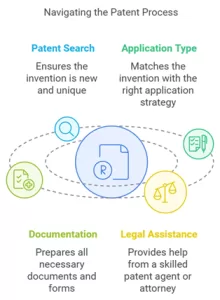How Long Does It Take to File a Patent in India?

Getting a patent in India is key for businesses and inventors. The process is complex and takes time. It involves several steps and requirements.
Knowing the time taking to file a patent and important stages is vital. It helps protect your innovations and inventions.
Understanding the Indian Patent Filing Process
Getting a patent in India means knowing about different patent types, what documents you need, and the first steps. Learning about these helps you protect your ideas in the Indian market.

Patent Filing in India
Types of Patent Applications in India
In India, you can choose from several patent options:
- Provisional Patent Applications: These give early protection as you work on your invention.
- Complete (or Regular) Patent Applications: These are the main patent applications that get a detailed check.
- Patent Cooperation Treaty (PCT) Applications: These offer global patent protection with a single filing.
Required Documentation and Forms
To file a patent in India, you must provide certain documents:
- Completed patent application form (Form 1)
- Detailed patent specification
- Drawings or figures (if needed)
- Power of Attorney (if using a patent agent)
- Priority document (if claiming earlier application priority)
Initial Filing Requirements
Before you file, make sure you:
- Have done a deep search to show your invention is new and unique
- Know which patent application type fits your invention and strategy
- Have all the required documents and forms ready
- Have a skilled patent agent or attorney to help, if you need one

Navigating patent process
Understanding these key parts of the Indian patent process helps you confidently start protecting your intellectual property.
How Long Does It Take to File a Patent in India?
Getting a patent in India is a detailed process. Many things can affect how long it takes from start to finish. Knowing how long it usually takes is key for inventors and companies wanting to protect their ideas.
The Indian Patent Office says it takes about 2 to 5 years to get a patent. This includes the time to file, examine, and decide on the patent. The exact time can change based on the patent type and how complex the application is.
| Stage | Description | Timeline |
| Novelty Search | Searching prior art to ascertain existence of similar inventions. | Varies from 3 days to 10 days |
| Preparation | Drafting the patent application, including specifications and claims. | 1-3 weeks (varies by complexity). |
| Filing | Submission of the patent application to the Indian Patent Office. | 1 day (after preparation). |
| Publication | Application is published in the Patent Journal. | Default: 18 months from filing; Early publication: 1 month from request. |
| Examination | Request for examination and review of the application. | Typically starts within 6–8 months from request. |
| Grant of Patent | Final grant after successful examination and addressing objections. | Normal route: 2–3+ years; Expedited route: 1–1.5 years. |
The time it takes to file and process a patent can change. This is due to the invention’s complexity, how many applications are pending, and how quickly the applicant responds. Also, the patent grant duration can differ based on the Indian patent system rules.
Knowing these typical times helps inventors and companies plan better. They can make sure their ideas are protected when they need to.
Patent Application Examination and Review Stages
In India, the patent review process checks if a patent application is legal and meets technical standards. This step is crucial for getting a patent. It decides if the application will succeed.
First Examination Report (FER)
The first step is the First Examination Report (FER) from the patent office. The FER points out any issues or objections with the application. The applicant must reply within a set time, fixing the problems mentioned by the examiner.
Response Timeline to Office Actions
- Applicants have 6 months to answer the FER. They can change the application or add more details to meet the examiner’s needs.
- If the examiner is not happy with the response, they might send more office actions. These ask for more information or changes.
- Applicants usually have 6 months to reply to these follow-up actions. The exact time depends on the patent office’s rules.
Final Decision Process
After all responses, the patent examiner makes a final choice. This can be granting the patent, rejecting it, or asking for more changes before deciding. However, an opportunity to present the case is given by means of video conferencing meeting for complex inventions. This stage may further increase the timeline by about 3-6 months.
| Stage | Timeline |
| First Examination Report (FER) | 6 months to respond |
| Subsequent Office Actions | 3-6 months to respond |
| Final Decision | Varies based on application |
The patent review process in India aims to ensure patents are valid and of high quality. It protects inventors’ rights and encourages innovation. Knowing the stages and timelines helps applicants improve their chances of getting a patent.
Factors Affecting Patent Processing Time
Getting a patent in India can be tricky. Many things can slow down your application. Knowing these can help you guess when you’ll get your patent.
The technological complexity of your invention matters a lot. The more advanced your patent, the longer it takes to review. This is true for patents in tech, medicine, or space.
The patent backlog at the Indian Patent Office also plays a big role. More patents mean more work for the office. This can make getting a patent take longer.
But, there are ways to speed things up. You can ask for faster review if your patent is important or if you’re applying internationally. This might cost more and need extra paperwork.
| Factor | Impact on Processing Time |
| Technological Complexity | Higher complexity leads to longer processing times |
| Patent Backlog | Increased backlog at the patent office results in longer delays |
| Expedited Examination | Can reduce overall processing time, but requires additional steps |
Knowing these factors helps patent applicants in India. It lets them plan better and find ways to make the process smoother.
Conclusion
In India’s fast-paced innovation scene, filing a patent is key for those wanting to protect their ideas. The time it takes to file a patent in India changes based on several things. These include the type of patent, how complex the invention is, and how quickly the applicant acts.
Knowing the steps in the patent application process helps. It lets applicants plan better. They can make their chances of getting a patent higher. This includes filing on time, answering office actions quickly, and understanding the review stages well.
As India grows as a place for new ideas, getting patents is more important than ever. Companies and inventors focusing on patents can protect their work. They can also use their patents to grow and innovate in India’s innovation world.
















